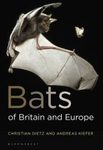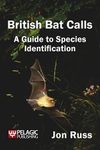"Bats of Trinidad and Tobago is one of the finest books thus far published about bats. It is thoroughly researched, provides comprehensive coverage of one of the world’s richest bat faunas and is outstandingly illustrated. It is an easy and fascinating read for the layperson yet will also serve as an essential reference work for professional bat biologists. Anyone interested in bats should own a copy."
– From the Foreword by Dr. Merlin D. Tuttle – Founder of Bat Conservation International
"I've been lucky enough to visit Trinidad and Tobago ten times as a filmmaker, directing many sequences about the islands' amazing bats for David Attenborough's Trials of Life, Tales of the Calypso Isles with Paul Keens-Douglas and other films. The phenomenal variety of species, many of whose behaviour had been studied in detail, and expert guidance from Farouk Muradali, Geoffrey Gomes and others made my trips very productive. It's wonderful to find so much expert bat knowledge distilled in this stunning, wide-ranging book, with remarkable photos and artwork and to see all the good things bats do as pest controllers, pollinators and seed dispersers highlighted."
– Dr. Nick Upton, Film-maker for the BBC/PBS
"Bats of Trinidad and Tobago is the most comprehensive treatment of these elusive and essential creatures to date, exploring their biology and ecology, human-bat interactions, and species accounts. Experts and novices alike will benefit tremendously from the substantial efforts of Geoffrey Gomes, who has worked tirelessly for decades in Trinidad and Tobago to research these animals. The world renowned illustrator, Fiona Reid, brings life to this meticulous work. My collaboration with Geoffrey has given me hope for bats' future conservation, and the publishing of this book will only embolden these efforts."
– Dr. Luke Rostant, University of the West Indies (UWl)
"Bats of Trinidad and Tobago offers a comprehensive guide on local bats with an eclectic Trinidadian style that uniquely presents the plight of one of the most misunderstood creatures on the planet. Bats are often dismissed locally as simply disease carrying creatures, which is far from the truth. [...] As this book clearly elucidates, bats represent keystone species that play vital roles in maintaining local ecosystems, and it is a misconception to equate bats in general with disease. While Bats of Trinidad and Tobago is a valuable resource for researchers, it captures the eye with its beautiful illustrations and is well formatted, making it an easy read suited to a wide range of audiences. It will certainly be an essential text for field naturalists for years to come."
– Dr. Janine Seetahal, DVM, MPH
"As with many field guides, the genesis of this book is firmly rooted in the two authors having a great passion and curious interest in the only mammal that has mastered the art of flight. Whether it be for conservation or education, this love of bats shines through from the entertaining writing style about their biology to the detailed descriptions and beautiful paintings of the species found on the twin islands of Trinidad and Tobago.
What distinguishes this publication from others in the genre are Geoffrey Gomes and Fiona Reid’s ability to break out of the formulaic field guide mold by balancing typical species accounts with an equally engaging presentation of the ecology of bats and their significance to people. Another nice aspect is the frequent reference to local examples that give the book a truly Trinidadian and Tobagonian flavor. Where else would we learn about the tradition of ‘Authentic Bats’ and ‘Fancy Bats’ in mass bands during Carnival?
A big inspiration to the authors comes from the founder of Bat Conservation International, Dr. Merlin Tuttle, who not only has written the Forward to the book but also generously provided stunning photographs, especially of bats in flight. In fact, there are many talented photographers and artists who have contributed to make this a great visual publication. Not the least of which are the exquisitely executed renderings of bats in the species accounts by Fiona. She has mastered a unique style that combines life-like poses while highlighting key identification features.
The book begins with an introduction to the presentation format and a good overview of the geography of the islands and their diverse habitats. The main text is divided into three parts beginning with a very thorough coverage of the natural history of bats. This section takes a holistic ecosystem approach to cover topics ranging from echolocation to roosting in a refreshing non-textbook way. They do one of the better jobs of articulating the importance of bats to the environment and dispelling ageold misunderstandings such as the false hysteria of vampires by early taxonomists trying to get a grasp of this unknown plethora of biodiversity being discovered in the New World tropics.
In the second part, I was impressed by the wealth of information on the relationships between bats and humans that is both broad in scope, covering topics such as folklore and rabies, while staying almost exclusively focused on examples from the islands. This is one of the benefits of having Gomes, a local Trini, as the first author. Especially interesting to me was a subsection on amazingly recognizable bat effigies portrayed in Pre-Columbian ceramic pottery of the Salodoid Amerindians living in Trinidad from about 500 BCE.
The last part of the book comprises the accounts of 68 species of bats currently known from Trinidad and Tobago, which represents about 70% of the mammalian diversity on the islands. Each species has a life-sized color illustration of the bat done by the second author. A feature not regularly seen in other field guides is a detailed subsection devoted exclusively to echo location calls specific to that species. This is one of the fastest growing areas of bat research that may eventually start a niche market that enables ecotourists to eavesdrop on these mysterious nocturnal flyers with bat detectors, which are becoming more readily available and cheaper in price.
The book is attractively packaged into almost 300 pages of a handy tablet-sized format that is self-published through Trinibats, a bat conservation organization in Trindad that the first author co-founded in 2011. As the first monograph on the bats of Trinidad and Tobago (Goodwin and Greenhall, 1961) spurred a wave of interest in researchers from throughout the world, the current contribution over half a century later will open up this fascinating world to the amateur naturalist while still being a useful reference to professional biologists. It sets a new standard for not only field guides but bat books in general."
– Burton K. Lim – Department of Natural History, Royal Ontario Museum, Acta Chiropterologica, 17(1), 2015






























